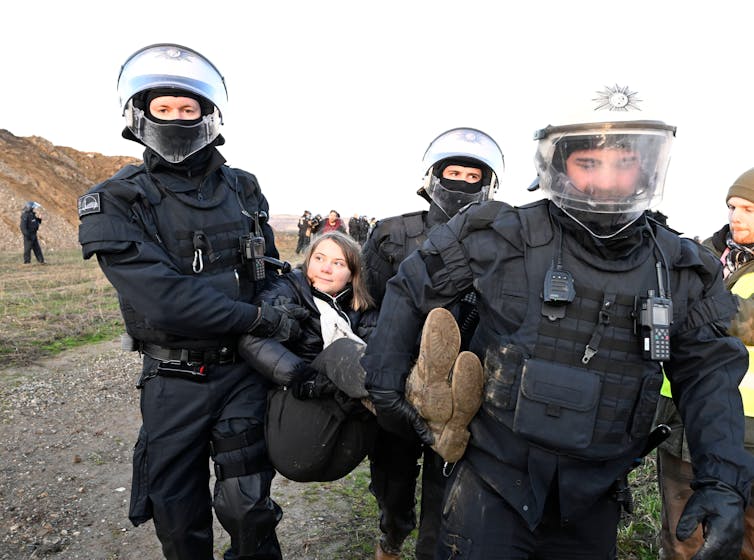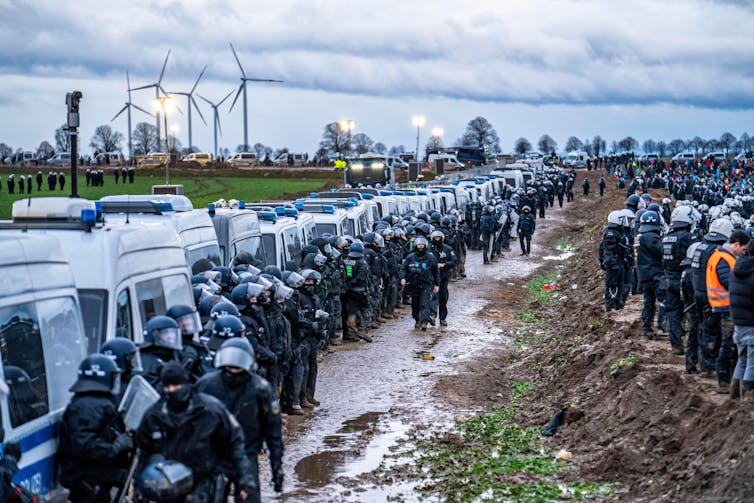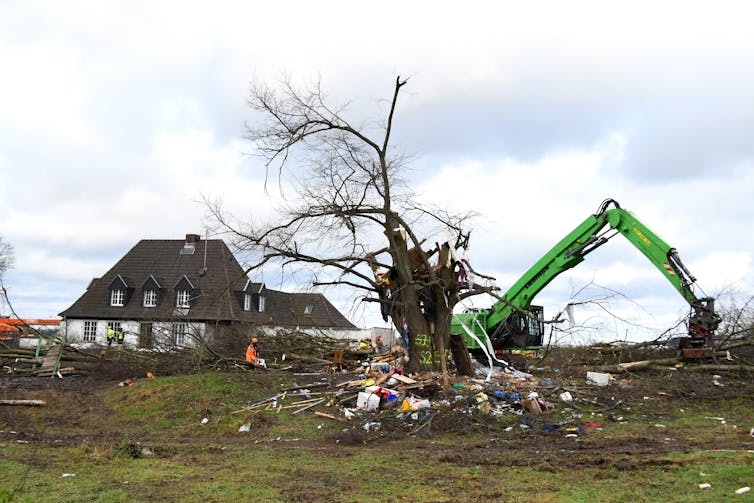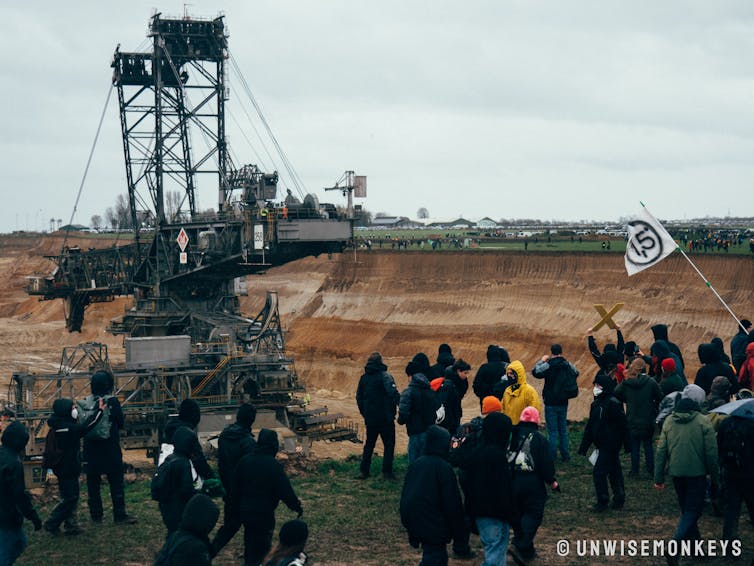In early 2023, the German village of Lützerath was the site of violent clashes between thousands of protesters and police who wanted to clear the village so it could be swallowed up by Garzweiler II, a huge opencast coal mine. In small groups, police forces charged into groups of protesters, beating people, kicking and pushing them to the ground. Police dogs attacked protesters, just metres away from the steep edge of the Garweiler II opencast coal mine. Dozens of people were injured.
The protests made world headlines when Greta Thunberg joined in and was detained by police.
The police would eventually drive the protesters out of the village, using batons, pepper spray and dogs (the local police point out these were “legally permitted means of physical violence” and “were only used to avert dangers to public safety and order”). The bulldozers then moved in. Today, as one activist put it, “the place where Lützerath used to be looks just like the rest of the post-mining wasteland around it”.
Lützerath was particularly high-profile, but other villages in the region have suffered the same fate. In my academic research I have tracked how the regional police have long collaborated with energy firm RWE to ensure the expansion of coal mines isn’t held up by local objections.
Protests in Lützerath began after almost all of its residents were forced to sell and leave a few years ago. Expropriation of land for mining is a touchpoint in Germany as the modern Federal Mining Act that enables it came out of old Nazi legislation which allowed the eviction of communities for coal excavation in Germany’s quest to strengthen its wartime capabilities.
In close allyship with surrounding communities and the last remaining farmer, Eckardt Heukamp, activists built barricades, tree houses, tunnels, and tripods, and moved into empty homes to stop the destruction of the village and prepare for a final confrontation with police and the mine’s operator, energy giant RWE. (In a statement provided to The Conversation, the local police said it is obliged to prosecute “anyone who stays [in the mining area] against the will of the owner”).
Heukamp lost his court case against RWE in 2022 and had to leave and see his family farm destroyed. This is the second time he was dispossessed for coal.
The demonstrations in early 2023 were protesting the eviction of those activists to allow RWE to extract and burn a thick layer of lignite coal underneath the village. Sometimes known as brown coal, lignite is the dirtiest form of coal, and a further 280 million tonnes of it will be extracted from Garzweiler mine alone.
Lützi Lebt/flickr, CC BY-NC-SA
Studies show that this coal is not necessary for Germany’s energy supply. But it is part of a controversial deal between RWE and the Green-Conservative coalition government which brings forward the end date of lignite coal mining in Germany from 2038 to 2030, “saving” five similar villages, but sacrificing Lützerath. But by reconnecting two generating units and increasing annual extraction, the amount of total coal burnt is hardly reduced at all.
A history of resistance

Wolfgang Rattay / Alamy
The fight to protect Lützerath was part of a decades-long history of direct actions and combative resistance in the Rhineland. For instance the nearby Hambacher Forest occupation, set up in 2012, protected ancient woodland from the expansion of another RWE coal mine. The occupation became a symbol for resistance – “love, live, resist” – inspiring people across Germany and beyond.
For ten years, evictions were followed by reoccupations, as people risked their lives to stop ecological destruction. The last eviction, in 2018, took over four weeks until stopped by the courts, and was later declared illegal. A young film maker, Steffen Meyn, died when he fell around 20 meters from a tree bridge during the eviction.
While the eviction and destruction of the forest were eventually stopped, only a small percentage of the original woodland remains. Heat from the nearby mine means the forest is reported to be slowly drying out.
RWE has often been able to count on the support of police and politicians to combat resistance. In 2015, it emerged that the then-district administrator responsible for policing anti-coal protest was himself a member of RWE Power’s supervisory board, while Greenpeace research found that at least 17 politicians from all political parties – from mayors to parliamentarians – have had side jobs at the company. (In response, the local police said they are “committed to political neutrality [and] are not guided by private or economic interests. We act exclusively on a legal basis.”)
For decades, RWE has fostered its image as a “responsible neighbour”, thanks to the firm’s PR and corporate social responsibility (CSR) work and the support of regional media and government. Police have long collaborated, retweeting RWE press messages, using its vehicles to transport protesters, and effectively outsourcing the most difficult (tunnel) eviction work to RWE’s own private fire brigade by declaring it a “rescue”. (The police say this did happen but deny it was an example of collaboration. “Rather”, a spokesperson told The Conversation, “it is a matter of clear, legally-assigned responsibilities”).

Jochen Tack/Alamy
Revolving door relationships lubricate the political manoeuvring to defend coal at all costs. In late 2022, for instance, a close aide of Germany’s minister for foreign affairs and former leader of the Green Party left to become RWE’s chief lobbyist. (The Conversation contacted RWE for comment on whether this was an example of a “revolving door” situation but received no response).
For decades, RWE has paid communities in shares, not cash, which means that many become financially dependent on the company. Nearly a quarter of RWE’s shares are owned by communities, cities and towns. Local authorities are thus shareholders, licensers, clients, constituencies, employees and tax collectors at the same time.
Blurry boundaries between corporation and state
The boundaries between RWE and the federal state of North Rhine Westphalia (NRW) are so blurry the state is sometimes termed “NRWE”. When I studied RWE’s counterinsurgency strategies in the region I found the firm’s interests were represented everywhere, from church choirs and town councils, to school boards and universities.
RWE has financed police barbecues and fire trucks, I was told, sponsored football clubs and festivals, concerts and exhibitions, viewing platforms and historic castles, regularly organises lectures and restoration conferences. It puts up baking carts and public bookshelves, pays for school buildings, organises volunteering activities and tours through the mine. Employees go into schools and hand out lunch boxes to first graders. They create teaching materials, role-playing games, and girls’ days in their training centres, offer school trips into power stations, zoo schools, and environmental education initiatives. (RWE did not respond to a question on whether it has bought support among local communities).

Barbara Schnell, Author provided
Back in the 1980s, a scientific report highlighted the ecological destruction caused by mining in the region – but publication was blocked by the state government. More recently, RWE has been able to influence legislation – Der Spiegel reported in 2022 that parts of Germany’s coal phase-out laws, which ensured the Garzweiler mine would stay open, were based on studies paid for by the company. RWE has previously confirmed it funded the studies but said everyone had “free access to the documents”.
RWE has also paid for research on how to understand resistance to its own actions. All of these are classic counterinsurgency strategies to repress, pacify and co-opt dissent, smoothed over by a well-oiled propaganda machine.
The eviction of Lützerath is over. But criminalisation and policing continue in the coal mining Rhineland. As police continue to protect fossil capital, enforcing ecological destruction, and being perceived to serve not just RWE but the many individuals and institutions that benefit financially from coal mine expansion, the fight goes on.
The Conversation approached RWE for comment but did not receive a response.

Don’t have time to read about climate change as much as you’d like?
Get a weekly roundup in your inbox instead. Every Wednesday, The Conversation’s environment editor writes Imagine, a short email that goes a little deeper into just one climate issue. Join the 20,000+ readers who’ve subscribed so far.
Credit: Source link




